
 |
Version: June 2, 2009 |
by Norman Bruderhofer, 2009
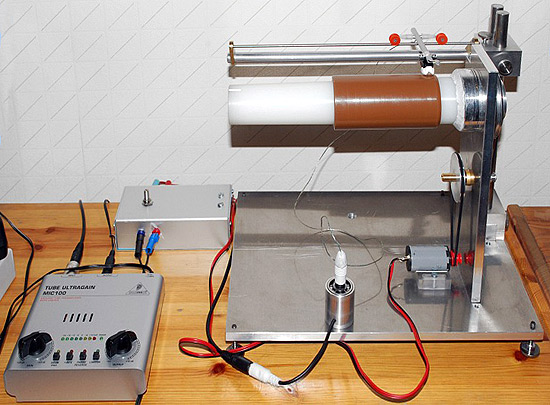
|
This project would not have been possible without the generous genius of Matthias Menz, who spent hours with me on the telephone over a period of many months discussing minuscule details, making the necessary technical drawings, and assembling the machinery itself. I therefore would like to give the largest portion of the credit to him. My Edison Home phonograph with an electric pickup has been a reliable and constant machine for me for over a decade. Several years ago however, I began to doubt the steadiness of the spring motor – even while it was well adjusted. Several comparisons proved my theory to be correct. Even the best working spring motor does have some significant flaws which can be mostly heard during drawn-out passages such as band accompaniment, voices and instrumental solos. It was even more difficult to electrify an existing phonograph in a non-destructive way. The construction of a revamped and brand new cylinder player was the most reasonable decision. Inspired by the article about direct tracking by Rob Lomas, the possibility of creating an arm with lower lateral resistance and tracking force proved to be quite realistic. This player then is the child of three years of experimental work on the design of a stand-alone electric cylinder player. The base is a 24 x 32 x 1 cm aluminum plate which holds the top-works assembly. It is easy to calibrate by using the adjustment screws on each corner. The motor is mounted on an acrylic block, held in place by two screws on the base plate. The motor itself is glued with an elastic power strip which is very reliable and also provides significant acoustic insulation. The upper middle plate is made from the same aluminum as the base plate and is tightly screwed in place from underneath. This plate supports the middle pulley transmission and the mandrel. A Swiss DC motor is equipped with a PVC pulley for two different speed transmissions and the belt connects to an inner aluminum pulley. It is mounted on a steel shaft which is connected to the triple axle on the rear. Again, the upper triple pulley is made from aluminum and is directly connected to the mandrel. The mandrel bearing is a recycled VCR head drum as once described by Joe Roeder. Most parts of the drum unit are kept and are clamped in the upper middle by this plate which can be easily removed. Its stability and extremely low resistance could not have been more satisfactory. The mandrel is a precise CNC cut made from polypropylene.
| |
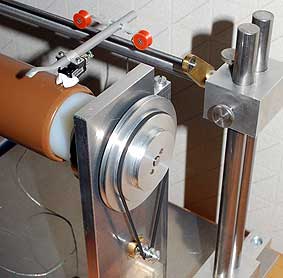 |
 |
| The tone arm can be adjusted vertically by sliding along the parallel rods to the right. | The inner pulley to the left recieves the belt from the motor and the triple pulley to the right passes the rotation on to the mandrel. |
|
The approximate length of 23 cm allows the play of even severely shrunken cylinders and records of longer duration, such as Ediphone and Columbia 20th Century formats. The different pulley transmissions were originally designed to have the maximum possible speed range. Therefore, the depicted configuration proves to be very comprehensive with a speed range from approx. 40 to 210 rpm. The assembly which holds the arm in place is variable in height and the distance and can be easily adjusted by using the knurled screw on the side. This flexible construction allows the user to adjust the complete system to almost any desired position. The arm itself is a aluminum tube on which two V-shaped PVC wheels are mounted on two miniature ball bearings. The angle of these wheels is also adjustable. Furthermore, they can be simply removed and substituted with wheels of different sizes, if necessary. The cartridge is a regular Stanton 500 which accommodates the remarkable availability of different styli.
| |
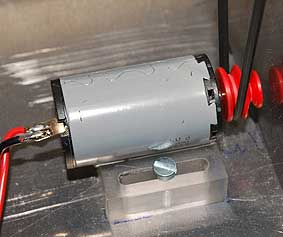 |
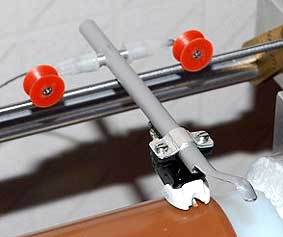 |
| The motor is mounted on an acrylic block, held in place by two screws on the base plate. | The tone arm is very light and tracks the cylinder without any motor. |
|
By passive tracking, the player is totally independent from any fixed groove thread. The wire to the tone arm is silver-shielded and teflon-coated and needs to be as long as possible to form a wide S-shaped loop for lowest lateral resistance. This is absolutely essential when playing cylinders with shallow grooves, such as brown wax and some early indestructible cylinders. The wire is fixed to a specifically designed swivel connector and then connected to the pre-amplifier. The current pre-amp is a Behringer Tube Ultragain MIC100 which provides excellent linear amplification, and adjustable values for input and output volume. The power supply contains high-quality circuitry for the precise selection of voltage and allows the input of 12-24V DC or AC current. The whole unit is quite portable and can be assembled / disassembled within minutes. The use of these different adapters also allows the use of irregular cylinder diameters such as Pathé Intermédiaire and Concert records.
| |
 |
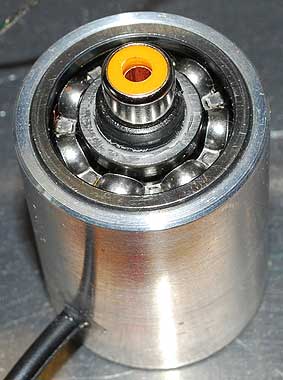 |
| The bottom of the tone arm assembly, which can be removed for transport. | A swivelling connector recieves the wire from the pickup. |

| Write to Norman Bruderhofer: | Visit Norman Bruderhofer: | |
 |
